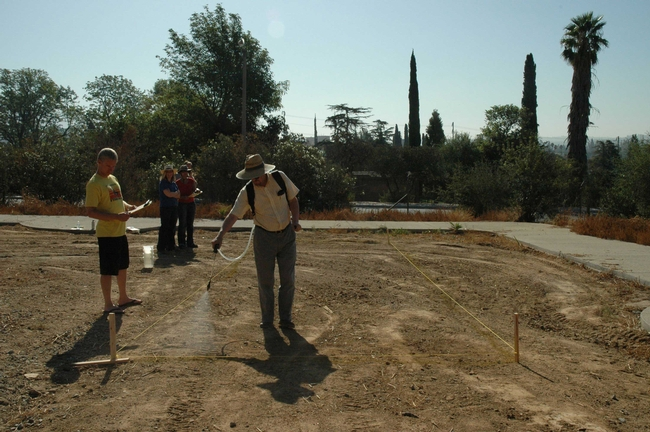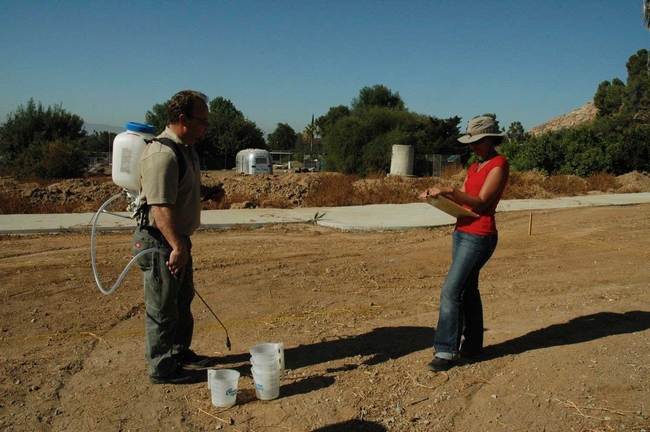From the Invasive Plants in Southern California blog :: Jan. 24, 2014
Tips on applying herbicides
The table below is from training that my colleagues Dr. Cheryl Wilen, Area Advisor, UC IPM; Dr. Milt McGiffen, Extension Specialist, UC Riverside; and I did in southern California at four locations in 2009/2010 with a total of 80 people that all had previous experience applying herbicides on invasive plants. This training utilized the 128th acre sprayer calibration method (more on that below).
| SPRAYER TYPE | MEAN GALLONS PER ACRE (GPA) SPRAY VOLUME | GPA RANGE | GLYPHOSATE QUARTS/ACRE APPLIED AS A 1% SOLUTION-MEAN (RANGE) |
| Backpack | 41 | 10-100 | 1.64 (0.4-4) |
| Orchard Gun | 127 | 24-352 | 5.2 (0.96-14) |
| Spot Spray | 628 | 80-1560 | 25.2 (3.2-63.6) |
A few points are evident from the table:
- With the same individuals, the mean spray volume and mean herbicide application rate vary considerably between sprayer type
- This ranged from 41 with the backpack sprayer to 628 with spot spraying (using a backpack sprayer)
- Mean herbicide application rate ranged from 1.64 quarts per acre to 25.2 qts/A
- If the desired herbicide rate was 2qts/ac, within one type of sprayer, the range of spray volume and herbicide rate varied widely:
- With the backpack sprayer, the herbicide rate varied from less than ½ quart to one gallon
- Only 9 of the 80 people were within 10% of the desired rate
- With the orchard gun, only one person was within 10% of the desired rate, 2 were below and 77 were above
- One person applied 3.5 gallons of herbicide/acre
- The spot spray application? Forget-about-it!
- Everyone was way above, the highest rate was 15.6 gallons of herbicide/acre!!!!
So what's the point of this? Using too much herbicide wastes money, time, resources, can be illegal, has the potential to pollute the environment, can kill plants you don't want to kill, and can result in very bad public perceptions of what we do. Using too little is equally wasteful; you're just going to have to re-treat.
The solution, calibrate so you know how much herbicide you are spraying!
How do you calibrate? There are lots of ways. The one we have been teaching is the 128th acre method. I don't know who came up with this clever, no math method, but thanks.
The 128th acre method uses our crazy US system of units to make it easy to calibrate hand held equipment for broadcast spraying (it doesn't work for spot spraying; we used a different method for that, but we are still working on a good way to calibrate for spot spraying).
In the photo below, a participant in the training is spraying within an area marked with stakes and string that is 10 feet wide by 34 feet long = 340 square feet = 128th of an acre (340 sq.ft./43560 sq.ft. per acre). Someone records the time in seconds needed to spray the area.
Then the person doing the calibration sprays for the same time in seconds into a bucket that can measure in ounces. There are 128 ounces in a gallon, so the number of ounces collected in the bucket were needed to spray 128th of an acre and therefore is the same as the gallons per acre (GPA) that would be applied in the field. So 30 ounces in the bucket would be 30 GPA! Simple!
When you know the GPA, you can calculate the exact amount of herbicide to put into the spray tank that will apply the recommended label rate. To make this process even simpler, we created a No-Math Sprayer Calibration Worksheet that walks you through these calculations. So all you need for the whole process is the sprayer, the trainees, a measuring tape, something to mark the area, a watch or timer with a secondhand, a calculator and a reasonable ability to follow directions.
Click below for the No-Math Sprayer Calibration Worksheet.
Attached Files:

